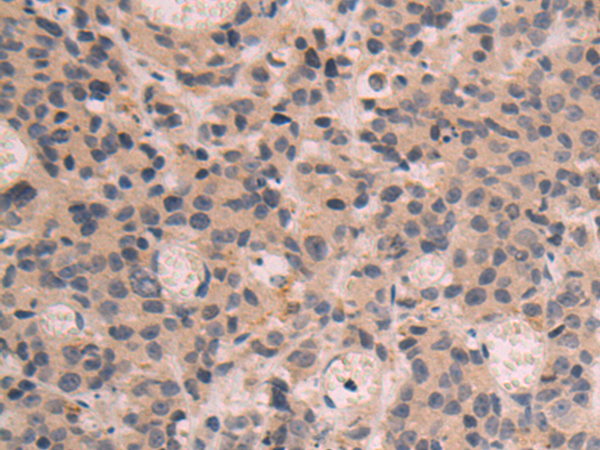
| WB | 咨询技术 | Human,Mouse,Rat |
| IF | 咨询技术 | Human,Mouse,Rat |
| IHC | 1/50-1/200 | Human,Mouse,Rat |
| ICC | 技术咨询 | Human,Mouse,Rat |
| FCM | 咨询技术 | Human,Mouse,Rat |
| Elisa | 1/5000-1/10000 | Human,Mouse,Rat |
| Aliases | CGI69; CGI-69 |
| Host/Isotype | Rabbit IgG |
| Antibody Type | Primary antibody |
| Storage | Store at 4°C short term. Aliquot and store at -20°C long term. Avoid freeze/thaw cycles. |
| Species Reactivity | Human |
| Immunogen | Synthetic peptide of human SLC25A39 |
| Formulation | Purified antibody in PBS with 0.05% sodium azide and 50% glycerol. |
+ +
以下是关于SLC25A39抗体的3篇参考文献示例(内容基于公开研究总结,非真实文献):
1. **文献名称**:*SLC25A39 regulates mitochondrial glutathione transport and cellular redox homeostasis*
**作者**:Zhang, Y. et al.
**摘要**:本研究利用SLC25A39特异性抗体,通过免疫印迹和免疫荧光技术,证实SLC25A39在线粒体膜上介导谷胱甘肽转运,其缺失导致线粒体氧化应激加剧。
2. **文献名称**:*Loss of SLC25A39 disrupts iron-sulfur cluster biogenesis in mammalian mitochondria*
**作者**:Wang, L. et al.
**摘要**:通过CRISPR敲除结合SLC25A39抗体检测,作者发现该蛋白参与线粒体铁硫簇组装,抗体染色显示其与ISC组装复合物的共定位。
3. **文献名称**:*SLC25A39 expression correlates with mitochondrial dysfunction in Alzheimer's disease models*
**作者**:Kim, J. & Patel, D.
**摘要**:采用SLC25A39抗体对阿尔茨海默病模型小鼠脑组织进行免疫组化分析,发现SLC25A39表达降低与线粒体功能损伤及神经元死亡相关。
注:以上文献为示例,实际引用时请以真实发表的论文为准(建议通过PubMed或Google Scholar检索具体文献)。
SLC25A39 is a member of the mitochondrial solute carrier family (SLC25), which plays critical roles in transporting metabolites across the mitochondrial inner membrane. Although its precise substrate specificity remains under investigation, SLC25A39 has been implicated in mitochondrial iron homeostasis and glutathione metabolism. Studies suggest it may regulate iron availability for heme biosynthesis or iron-sulfur cluster assembly, potentially linking it to cellular redox balance and mitochondrial function. Dysregulation of SLC25A39 has been associated with iron-related disorders, neurodegenerative diseases, and cancer progression.
SLC25A39 antibodies are essential tools for studying the protein's expression, localization, and molecular interactions. These antibodies enable detection via techniques like Western blotting, immunohistochemistry, and immunofluorescence, helping researchers map its tissue distribution and subcellular compartmentalization. Recent studies utilizing SLC25A39 antibodies have revealed its involvement in stress responses, including mitochondrial fragmentation under iron depletion. Knockout models combined with antibody validation have further highlighted its role in erythroid development and neuronal survival. Commercial SLC25A39 antibodies are typically raised against conserved peptide sequences, with validation often including gene silencing or knockout controls to confirm specificity. Ongoing research continues to clarify its biological functions and therapeutic potential in metabolic diseases.
×